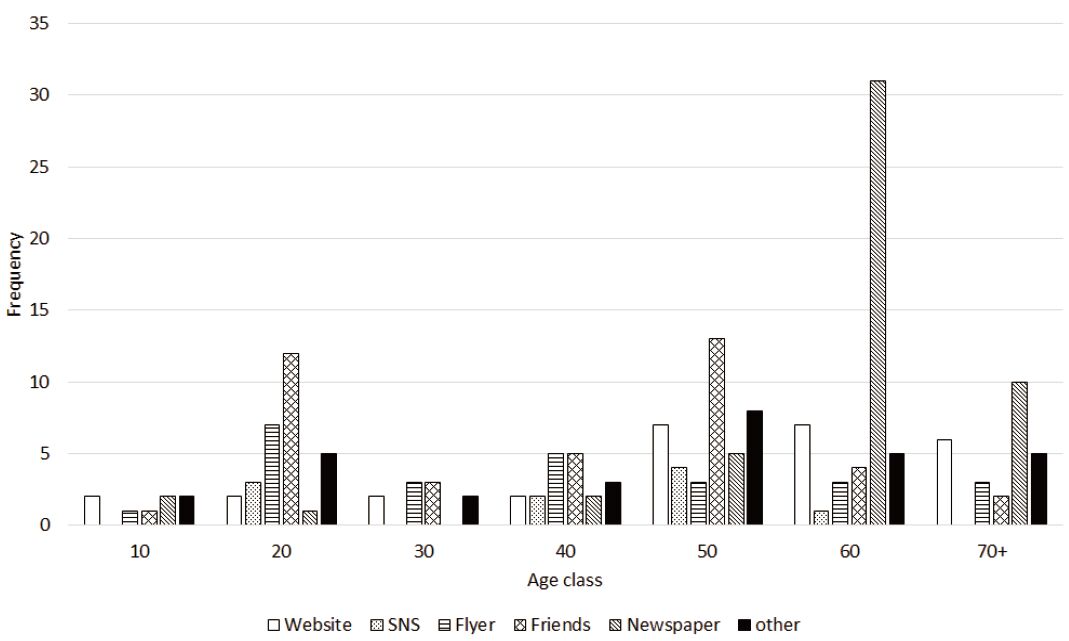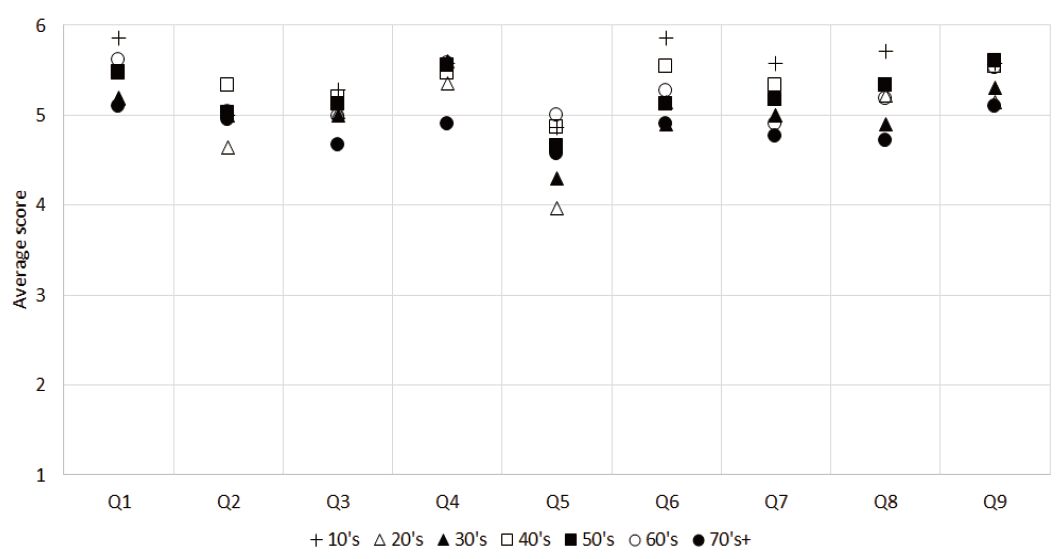|
<NOTE>
How was the Mahale 50 Exhibition and Symposium Assessed by the General Participants? A Questionnaire Survey
Sana Inoue1 & Kazuhiko Hosaka2
1 Konan Women’s University, Japan 2 Kamakura Women’s University, Japan INTRODUCTION The year 2015 marked the 50th anniversary of wild chimpanzee studies at Mahale Mountains National Park, Tanzania. During this half-century, a number of scientific findings have been published by no less than 80 researchers from Japan, North America, Europe, and Tanzania, and those contributions to the scientific community are recognized worldwide (Nishida 2012; Nakamura et al. 2015). The pivotal team involved in these studies, now called the Mahale Mountains Chimpanzee Research Project (MMCRP), organizes researchers studying chimpanzees and other wildlife at Mahale. MMCRP obligates its researchers to contribute to the activities of the Mahale Wildlife Conservation Society (MWCS), which was established in 1994 (Nishida & Nakamura 2008; Hosaka & Nakamura 2015). One of the aims of MWCS is to raise public awareness of the importance of wildlife research and conservation at Mahale, because researchers’ work is supported by public and private funding. Despite their long history of achievements, researchers have faced the reality that their efforts are little known to the public, even in Japan, which is self-evident when their renown is compraed with the fame of another long-term wild chimpanzee research at Gombe National Park, Tanzania. In 2015, a rare outreach event commemorating the 50th anniversary of chimpanzee research at Mahale was conducted in Tokyo. Through various channels, e.g., the distribution of flyers and posters; announcements in MWCS newsletters; coverage in Japan’s two largest newspapers; pre-events at Tama Zoological Park; and notices on the websites of MWCS, the World Wildlife Fund (WWF), and Tokyo Zoological Park Society; the executive committee issued a call to the general public to encourage their participation in the event. Active researchers prepared poster exhibitions featuring 21 topics relating to research and conservation at Mahale, while in the symposium young and old researchers, ranging in age from twenties to seventies, gave talks about history, ongoing studies, and the future of Mahale (Hosaka 2015). This report aims to investigate the reactions of general participants in the event in order to obtain some useful information concerning wildlife research projects’ planned public outreach programs. METHODS A questionnaire survey was conducted at the University of Tokyo’s Yayoi Auditorium Ichijo Hall on September 19, 2015 where the Mahale 50 Exhibition and Symposium was held. At the reception, questionnaire sheets were distributed to 320 participants. After the symposium, in order to assure voluntary submission, the participants were asked to post completed sheets into a collection box. This survey was approved by the Research Ethics Committee of Kamakura Women’s University (#15109). Questionnaire The sheet contained informed consent, 16 questions concerning respondents’ attributes, and comments about the event. The respondents were asked to write answers (q1–2, 16), select from multiple choices (q3–5, 15), and to rank questions on a six-point scale: “1” (strongly disagree) to “6” (strongly agree) (q6–14). (q1) Sex (q2) Prefecture (q3) Age class (10’s, 20’s, 30’s, 40’s, 50’s, 60’s, 70 or over) (q4) Occupation (office worker, student, homemaker, self-employed, other) (q5) How did you receive information about the event (websites, SNS, flyers, friends, noticed as I was passing by, newspaper, other) (q6) Q1: When you received the information, did you become interested in the content? (q7) Q2: When you received the information, did you understand the aims of the symposium? (q8) Q3: Was the information about the symposium easy to understand? (q9) Q4: Did you enjoy the symposium? (q10) Q5: Did the symposium meet your expectations? (q11) Q6: Has the symposium deepened your interest in chimpanzees? (q12) Q7: Has the symposium deepened your interest in Africa? (q13) Q8: Has the symposium deepened your interest in “research” or “study”? (q14) Q9: Would you like to participate in a similar event? (q15) What kind of programs would you like us to plan, if you were to participate again? (exhibitions, symposia, science cafés, extension lectures, on-demand lectures, other) (q16) What impressed you most in the symposium as a whole? RESULTS 196 sheets were collected and the number of valid responses was 170. Respondents’ attributes The sex ratio of respondents was balanced, while age class distribution was biased towards the 50’s and 60’s age groups, which accounted for approximately 52% (Table 1). Most respondents (87%) were from the Kanto region, including Tokyo, but some came from distant regions, north and south, such as Hokkaido and Kyushu. There were 28 students in the respondents. Table 1. Sex and age composition 
Information sources The information sources through which participants learned of the event differed between age classes (Figure 1). Flyers were quite common for the 40’s group, while less so for those in their 60’s (χ² (6) = 12.92, p < 0.05). Friends acted as the most common sources for the 20’s group, while less so for the 60’s group (χ² (6) = 17.69, p < 0.01). Newspaper coverage acted as an important source for the 60’s group, while less so for either the 20’s, 30’s, or 50’s groups (χ² (6) = 50.35, p < 0.01). There was no statistical difference in the importance of either websites (χ² (6) = 5.15, n.s.) or SNS (χ² (6) = 7.59, n.s.). 
Figure 1. Age class distribution of information sources about the event. Assessment of the symposium Overall, the responses of the participants were positive, irrespective of the questions (Figure 2). Their expectations before the event were high (Q1, 5.42 ± 0.89; Q2, 4.98 ± 1.02; Q3, 5.02 ± 0.96), and so was their level of satisfaction after the event (Q4, 5.44 ± 0.78; Q5, 4.64 ± 1.17; Q6, 5.19 ± 0.87; Q7, 5.04 ± 0.93; Q8, 5.18 ± 0.89; Q9, 5.42 ± 0.77). Examining the relationships between the scores for nine answers each respondent gave showed that they were positively correlated with each other (r = 0.30 to 0.67, p < 0.01) except for Q2–Q7and Q2–Q8 (r = 0.19, 0.26, n.s.). 
Figure 2. Scores for nine questions averaged for respondents of each age class. What kind of outreach programs were preferred? Respondents of all age classes preferred symposia over six alternatives, while on-demand lectures and exhibitions were less preferred (Figure 3). The preference for “science cafés,” which involve face-to-face presentations and conversations in casual settings, varied according to age: it was strong in the 30’s group (0.70), while weak in the 60’s group (0.18) (χ² (6) = 15.23, p < 0.05). In contrast, the preference for “extension lectures,” special courses usually offered by universities as social contributions, was strong in older generations (40’s–70’s+), while weak in younger generations (10’s–30’s) (χ² (6) = 17.71, p < 0.01). 
Figure 3. Variation of preferences for various kinds of outreach programs across age classes. DISCUSSION The event was successful in terms of the number of participants, which exceeded expectations (Hosaka 2015). Most participants not only seemed satisfied with the symposium but also shared intellectual curiosity with the host researchers (Q4–8, Figure 2). In the comments for q16, many respondents noted that they admired the ambitions of the pioneers who explored Western Tanzania in the 1960s and also mentioned that they had great expectations for young scientists present at the symposium, who were full of abiding enthusiasm and brand-new methodology. This showed that the event had also been successful in terms of aims of the symposium (Hosaka 2015). According to the results for Q9 (Figure 2), most respondents expected to attend similar outreach events in the future. In order for these events to fulfill expectations, it would be fruitful to use the results of this questionnaire to derive some suggestions for improvements, which may also be useful for other research organizations. The first suggestion is to target a specific audience. It should be noted that the average score for Q5 (Figure 2) was slightly lower than scores for Q4 and Q6–Q8, which implies that the symposium had not met the expectations of some participants. The audience for this event was not restricted to a certain generation and it is difficult to satisfy audiences across generations. For instance, some younger participants may have expected an array of recent advancements, while some older participants may have been simply interested in accounts of the earliest days of research. The second suggestion is to determine what kind of outreach program would fit the target audience. It seems that symposia were the most preferred format across generations (Figure 3); hence, it is important to organize symposia on a regular basis. It also seems evident that younger generations enjoy science cafés, while older generations prefer extension lectures. Considering that symposia cannot be held very often, researchers ought to exploit such alternative opportunities. The third suggestion is to optimize public relations strategy depending on the target audience. In this study (q5, Figure 1), the effect of “websites” and “SNS” was present across generations but these were merely complementary as public relations tools. “Flyers,” distributed at zoos in Tokyo and Yokohama, seemed effective for the middle-aged, implying that zoos are attracting middle-aged visitors curious about wild animals. “Newspaper” was the strongest tool for over-sixties, while it had the least effect on younger generations, possibly due to the decline in newspaper readership. “Friends” seemed to be an important source for people ranging in age from twenties to fifties. In marketing, word of mouth communication is believed to have a major impact on consumer purchasing behavior (e.g., Chevalier & Mayzlin 2006). ACKNOWLEDGMENTS We would like to express our sincere gratitude to the executive committee of Mahale 50 Tokyo and the student staff from Teikyo University of Science for their cooperation in this survey, and also to the participants who kindly completed the questionnaire. REFERENCES Chevalier JA, Mayzlin D 2006. The effect of word of mouth on sales: Online book reviews. J Mark Res 43:345–354. Hosaka K 2015. Mahale 50 Kyoto, Tokyo & Kigoma. Pan Afr News 22:14. Hosaka K, Nakamura M 2015. Conservation and the future. In: Mahale Chimpanzees: 50 Years of Research. Nakamura M, Hosaka K, Itoh N, Zamma K (eds), Cambridge University Press, Cambridge, pp. 679–690. Nakamura M, Hosaka K, Itoh N, Zamma K (eds) 2015. Mahale Chimpanzees: 50 Years of Research. Cambridge University Press, Cambridge. Nishida T 2012. Chimpanzees of the Lakeshore: Natural History and Culture at Mahale. Cambridge University Press, Cambridge. Nishida T, Nakamura M 2008. Long-term research and conservation in the Mahale Mountains, Tanzania. In: Science and Conservation in African Forests: The Benefits of Long-term Research. Wrangham RW, Ross E (eds), Cambridge University Press, Cambridge, pp. 173–183. Back to Contents |